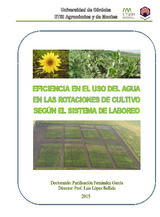Mostrar el registro sencillo del ítem
Eficiencia del uso del agua en las rotaciones de cultivo según el sistema de laboreo
| dc.contributor.advisor | López Bellido, Luis | |
| dc.contributor.author | Fernández García, María Purificación | es_ES |
| dc.date.accessioned | 2016-02-24T08:38:55Z | |
| dc.date.available | 2016-02-24T08:38:55Z | |
| dc.date.issued | 2016 | |
| dc.identifier.uri | http://hdl.handle.net/10396/13272 | |
| dc.description.abstract | En condiciones de secano mediterráneas, la producción de garbanzos, habas y girasol se puede aumentar mediante la mejora del contenido de agua del suelo (SWC). El estudio ha tenido lugar dentro del marco del experimento de larga duración denominado “Malagón” iniciado en 1986, situado en la campiña del Guadalquivir (Córdoba), en un suelo Vertisol (Typic Haploxererts) típico de la zona mediterránea. Estos Vertisoles se caracterizan por un elevado contenido de arcilla, bajo contenido de materia orgánica y alta capacidad de intercambio catiónico. El estudio se ha llevado a cabo en el periodo 2000-2009. Se utilizó un diseño experimental en parcelas sub-subdivididas con cuatro repeticiones siendo la parcela principal el sistema de laboreo (laboreo convencional (LC) y no laboreo (NL); las subparcelas la rotación de cultivos bianual: trigo (Triticum aestivum L.)- girasol (Helianthus annuus L.), trigo-garbanzo (Cicer arietinum L.), trigo-habas (Vicia faba L.) y la sub-subparcela la dosis de nitrógeno fertilizante aplicado al trigo (0, 50, 100, y 150 Kg N ha-1). Las determinaciones y medidas en los cultivos de garbanzo, girasol y habas han sido: el contenido de agua en el suelo hasta una profundidad de 90 cm en intervalos de 30 cm, tanto en siembra como en cosecha, el rendimiento de grano y los componentes de rendimiento de los cultivos. Se calcularon los siguientes índices: la eficiencia en el uso de la precipitación (PUE), el uso del agua (WU) y la eficiencia en el uso del agua (WUE), todos estos índices se expresaron en kg ha-1 mm-1 a excepción del WU que se midió en mm. Las diferencias de precipitación entre años influyeron en todas las medidas y coeficientes estudiados. El contenido de agua en el suelo en siembra fue mayor en el NL que en el LC en el perfil 0-30 cm de los tres cultivos estudiados (garbanzo, habas y girasol) siendo sus valores de 38.4 x 10-2, 37.8 x 10-2 y 38.2 x 10-2 m3 m-3 en el NL frente a 36.1 x 10-2, 36.1 x 10-2 y 36.2 x 10-2 m3 m-3 en el LC,... | es_ES |
| dc.description.abstract | Under rainfed Mediterranean conditions, chickpeas, faba beans and sunflower production can be increased by improving the soil water content (SWC). The study was conducted within the framework of a long-term experiment called “Malagon”, which began in 1986. The study area was located in Cordoba, southern Spain, on a Vertisol soil (TypicHaploxerts) tipical of the Mediterranean region, where rainfed cropping is the stardard practice. The Vertisol is characterized by a high clay content, low organic matter content and high cation exchange capacity. The study was performed over a period of ten years (2000-2009) and designed considering a randomized complete block with a split split plot arrangement and four blocks. Main plots were tillage systems, conventional tillage (CT) and no tillage (NT), subplots were crop rotation with three 2-year rotations (wheat (Triticum aestivum L.)-sunflower (Helianthus annuus L.), wheat-chickpea (Cicer arietinum L.) and wheat-faba bean (Vicia faba L.) and sub-subplot was N fertilizer rate (0, 50, 100 and 150 kg N ha-1) applied to wheat. The data collected were the soil water content, recorded before sowing and after harvesting, in 30 cm increments up to 90 cm, the grain yield and the yield components, for chickpea, faba bean and sunflower. The precipitation use efficiency (PUE), water use (WU) and the water use efficiency (WUE) were calculated and expressed in kg ha-1 mm-1 but WU, which was measured in mm. Highly significant differences were detected in all measures and ratios studied due to the large variation in rainfall between years. The soil water content at sowing was higher under NT treatment than under the CT treatment in the 0-30 cm soil layer for the three crops studied (chickpea, faba bean and sunflower) which improved seedbed conditions. The values of the NT treatment were 38.4 x 10-2, 37.8 x 10-2 and 38.2 x 10-2 m3 m-3 for the chickpea, faba bean and sunflower crops and the values of the CT treatment were 36.1 x 10-2, 36.1 x 10-2 and 36.2 x 10-2 m3 m-3, respectively. The NT treatment achieved a higher grain yield than the CT... | es_ES |
| dc.format.mimetype | application/pdf | es_ES |
| dc.language.iso | spa | es_ES |
| dc.publisher | Universidad de Córdoba, UCOPress | es_ES |
| dc.rights | https://creativecommons.org/licenses/by-nc-nd/4.0/ | es_ES |
| dc.subject | Suelos | es_ES |
| dc.subject | Contenido de Agua en el Suelo (CAS) | es_ES |
| dc.subject | Sistema de laboreo | es_ES |
| dc.subject | Cultivos | es_ES |
| dc.subject | Campiña del Guadalquivir | es_ES |
| dc.subject | Leguminosas | es_ES |
| dc.subject | Suelos Vertisol | es_ES |
| dc.subject | Trigo | es_ES |
| dc.subject | Girasol | es_ES |
| dc.title | Eficiencia del uso del agua en las rotaciones de cultivo según el sistema de laboreo | es_ES |
| dc.type | info:eu-repo/semantics/doctoralThesis | es_ES |
| dc.rights.accessRights | info:eu-repo/semantics/openAccess | es_ES |

